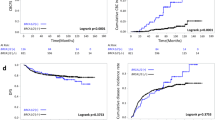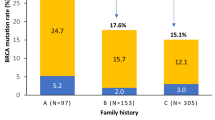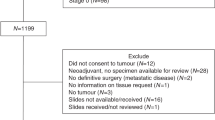Abstract
The abnormal expansion of a ≥36 CAG unit tract in the Huntingtin gene (HTT) leads to Huntington's disease (HD), but has also been associated with cancer: the incidence of cancer is lower in HD patients than in age-matched controls, but HD-causing variants of HTT accelerate the progression of breast tumors and the development of metastases in mouse models of breast cancer. To investigate the relationship between HTT CAGs and cancer, data concerning 2407 women with BRCA1 or BRCA2 mutations that predispose to breast and ovarian cancers and 431 patients with breast cancer without family histories were studied; the size of the CAG expansions on both HTT alleles was determined in each subject. The proportion of individuals carrying a CAG expansion in a pathological range for HD was 10 times more frequent than previously reported in the literature. In carriers of BRCA2 mutations, the length of the HTT CAG tract was correlated with lower incidence of ovarian cancer. Among carriers of BRCA1 mutations who developed a breast cancer, its onset occurred 2.4 years earlier in individuals with intermediate HTT alleles (≥27) than in those with a CAG tract <27. Finally, in patients with sporadic HER2 breast cancer, metastasis increased by a factor of 11.10 per 10 additional CAG repeats in HTT. We concluded that whereas long CAG length could be associated with lower cancer incidence, it could also be paradoxically associated with cancer severity (age of apparition and metastasis development).
Similar content being viewed by others
Log in or create a free account to read this content
Gain free access to this article, as well as selected content from this journal and more on nature.com
or
References
Group THsDCR: A novel gene containing a trinucleotide repeat that is expanded and unstable on Huntington's disease chromosomes: The Huntington's Disease Collaborative Research Group. Cell 1993; 72: 971–983.
Rubinsztein DC, Leggo J, Coles R, et al: Phenotypic characterization of individuals with 30-40 CAG repeats in the Huntington disease (HD) gene reveals HD cases with 36 repeats and apparently normal elderly individuals with 36-39 repeats. Am J Hum Genet 1996; 59: 16–22.
Andrew SE, Goldberg YP, Kremer B, et al: The relationship between trinucleotide (Cag) repeat length and clinical-features of Huntingtons-disease. Nat Genet 1993; 4: 398–403.
Snell RG, MacMillan JC, Cheadle JP, et al: Relationship between trinucleotide repeat expansion and phenotypic variation in Huntington's disease. Nat Genet 1993; 4: 393–397.
Semaka A, Hayden M : Evidence-based genetic counselling implications for Huntington disease intermediate allele predictive test results. Clin Genet 2013.
Killoran A, Biglan KM, Jankovic J, et al: Characterization of the Huntington intermediate CAG repeat expansion phenotype in PHAROS. Neurology 2013; 80: 2022–2027.
Ji J, Sundquist K, Sundquist J : Cancer incidence in patients with polyglutamine diseases: a population-based study in Sweden. Lancet Oncol 2012; 13: 642–648.
Sorensen SA, Fenger K, Olsen JH : Significantly lower incidence of cancer among patients with Huntington disease: an apoptotic effect of an expanded polyglutamine tract? Cancer 1999; 86: 1342–1346.
Moreira Sousa C, McGuire JR, Thion MS, et al: The Huntington disease protein accelerates breast tumour development and metastasis through ErbB2/HER2 signalling. EMBO Mol Med 2013; 5: 309–325.
Kelsey JL, Gammon MD, John EM : Reproductive factors and breast cancer. Epidemiol Rev 1993; 15: 36–47.
Narod SA, Foulkes WD : BRCA1 and BRCA2: 1994 and beyond. Nat Rev Cancer 2004; 4: 665–676.
Bojesen SE, Pooley KA, Johnatty SE, et al: Multiple independent variants at the TERT locus are associated with telomere length and risks of breast and ovarian cancer. Nat Genet 2013; 45: 384e371–372.
Antoniou AC, Wang X, Fredericksen ZS, et al: A locus on 19p13 modifies risk of breast cancer in BRCA1 mutation carriers and is associated with hormone receptor-negative breast cancer in the general population. Nat Genet 2010; 42: 885–892.
Chenevix-Trench G, Milne RL, Antoniou AC, et al: An international initiative to identify genetic modifiers of cancer risk in BRCA1 and BRCA2 mutation carriers: the Consortium of Investigators of Modifiers of BRCA1 and BRCA2 (CIMBA). Breast Cancer Res 2007; 9: 104.
Bieche I, Parfait B, Laurendeau I, et al: Quantification of estrogen receptor alpha and beta expression in sporadic breast cancer. Oncogene 2001; 20: 8109–8115.
Awadelkarim KD, Callens C, Rosse C, et al: Quantification of PKC family genes in sporadic breast cancer by qRT-PCR: evidence that PKCiota/lambda overexpression is an independent prognostic factor. Int J Cancer 2012; 131: 2852–2862.
Barnes DR, Lee A, Investigators E et al: Evaluation of association methods for analysing modifiers of disease risk in carriers of high-risk mutations. Genet Epidemiol 2012; 36: 274–291.
Antoniou AC, Sinilnikova OM, Simard J, et al: RAD51 135G—>C modifies breast cancer risk among BRCA2 mutation carriers: results from a combined analysis of 19 studies. Am J Hum Genet 2007; 81: 1186–1200.
Lee JM, Ramos EM, Lee JH, et al: CAG repeat expansion in Huntington disease determines age at onset in a fully dominant fashion. Neurology 2012; 78: 690–695.
Tassicker RJ, Teltscher B, Trembath MK, et al: Problems assessing uptake of Huntington disease predictive testing and a proposed solution. Eur J Hum Genet 2009; 17: 66–70.
Evans SJ, Douglas I, Rawlins MD, et al: Prevalence of adult Huntington's disease in the UK based on diagnoses recorded in general practice records. J Neurol Neurosurg Psychiatry 2013; 84: 1156–1160.
Morrison PJ, Harding-Lester S, Bradley A : Uptake of Huntington disease predictive testing in a complete population. Clin Genet 2011; 80: 281–286.
Fisher ER, Hayden MR : Multisource ascertainment of Huntington disease in Canada: prevalence and population at risk. Mov Disord 2013; 29: 105–114.
Moreira Sousa C, Humbert S : Huntingtin: here, there, everywhere!. J Huntingtons Dis 2013; 2: 395–403.
Elias S, Thion MS, Yu H, et al: Huntingtin regulates mammary stem cell division and differentiation. Stem Cell Rep 2014; 2: 491–506.
Goehler H, Lalowski M, Stelzl U, et al: A protein interaction network links GIT1, an enhancer of huntingtin aggregation, to Huntington's disease. Mol Cell 2004; 15: 853–865.
Thion MS, McGuire JR, Sousa CM, et al: Unraveling the role of Huntingtin in breast cancer metastasis. J Natl Cancer Inst 2015; 107: djv208.
Semaka A, Kay C, Doty C, et al: CAG size-specific risk estimates for intermediate allele repeat instability in Huntington disease. J Med Genet 2013; 50: 696–703.
Acknowledgements
We thank Frédéric Saudou, Anne Vincent-Salomon, the members of the Humbert and Saudou laboratories for discussions and the GEMO study: National Cancer Genetics Network (UNICANCER Genetic Group, France) and the patients for the biological samples. We also thank all the collaborating GEMO groups for their contribution to this study (a list of collaborating GEMO Centers and their members follows). The coordinating centers, Unité Mixte de Génétique Constitutionnelle des Cancers Fréquents, Hospices Civils de Lyon–Centre Léon Bérard and Equipe (Génétique du cancer du sein), Centre de Recherche en Cancérologie de Lyon: Olga Sinilnikova, Sylvie Mazoyer, Francesca Damiola, Laure Barjhoux, Carole Verny-Pierre, Alain Calender, Sophie Giraud, Mélanie Léone; and Service de Génétique Oncologique, Institut Curie, Paris: Dominique Stoppa-Lyonnet, Marion Gauthier-Villars, Bruno Buecher, Claude Houdayer, Virginie Moncoutier, Muriel Belotti, Carole Tirapo, Antoine de Pauw. Institut Gustave Roussy, Villejuif: Brigitte Bressac-de-Paillerets, Olivier Caron. Centre Jean Perrin, Clermont–Ferrand: Yves-Jean Bignon, Nancy Uhrhammer. Centre Léon Bérard, Lyon: Christine Lasset, Valérie Bonadona, Sandrine Handallou. Centre François Baclesse, Caen: Agnès Hardouin, Pascaline Berthet. Institut Paoli Calmettes, Marseille: Hagay Sobol, Violaine Bourdon, Tetsuro Noguchi, Audrey Remenieras, François Eisinger. CHU Arnaud-de-Villeneuve, Montpellier: Isabelle Coupier, Pascal Pujol. Centre Oscar Lambret, Lille: Jean-Philippe Peyrat, Joëlle Fournier, Françoise Révillion, Philippe Vennin, Claude Adenis. Hôpital René Huguenin/Institut Curie, St Cloud: Etienne Rouleau, Rosette Lidereau, Liliane Demange, Catherine Nogues. Centre Paul Strauss, Strasbourg: Danièle Muller, Jean-Pierre Fricker. Institut Bergonié, Bordeaux: Emmanuelle Barouk-Simonet, Françoise Bonnet, Virginie Bubien, Nicolas Sevenet, Michel Longy. Institut Claudius Regaud, Toulouse: Christine Toulas, Rosine Guimbaud, Laurence Gladieff, Viviane Feillel. CHU Grenoble: Dominique Leroux, Hélène Dreyfus, Christine Rebischung, Magalie Peysselon. CHU Dijon: Fanny Coron, Laurence Faivre. CHU St-Etienne: Fabienne Prieur, Marine Lebrun, Caroline Kientz. Hôtel Dieu Centre Hospitalier, Chambéry: Sandra Fert Ferrer. Centre Antoine Lacassagne, Nice: Marc Frénay. CHU Limoges: Laurence Vénat-Bouvet. CHU Nantes: Capucine Delnatte. CHU Bretonneau, Tours: Isabelle Mortemousque. Groupe Hospitalier Pitié-Salpétrière, Paris: Florence Coulet, Chrystelle Colas, Florent Soubrier. CHU Vandoeuvre-les-Nancy: Johanna Sokolowska, Myriam Bronner. CHU Besançon: Marie-Agnès Collonge-Rame, Alexandre Damette. Creighton University, Omaha, USA: Henry T Lynch, Carrie L Snyder. The study was supported by the Ligue National Contre le Cancer, the Association ‘Le cancer du sein, parlons-en!’ Award, and the Canadian Institutes of Health Research for the 'CIHR Team in Familial Risks of Breast Cancer' program. The EUROSCA Clinical study (EUROSCA/LSHM-CT-2004-503304) was supported in part by the European Union 6th framework program, and included the following principle investigators: J Berciano (Santander), Sylvia Boesch (Innsbruck), Alexis Brice (Paris), Alessandro Filla (Naples), Paola Giunti (London), Thomas Klockgether (Bonn), Ludger Schols and Olaf Riess (Tübingen), Maria Rakowicz (Warsaw), Caterina Mariotti (Milano), Bela Melegh (Budapest), Massimo Pandolfo (Brussels), Bart van de Warrenburg (Nijmegen).
Author information
Authors and Affiliations
Consortia
Corresponding authors
Ethics declarations
Competing interests
The authors declare no conflict of interest.
Additional information
Supplementary Information accompanies this paper on European Journal of Human Genetics website
Supplementary information
Rights and permissions
About this article
Cite this article
Thion, M., Tézenas du Montcel, S., Golmard, JL. et al. CAG repeat size in Huntingtin alleles is associated with cancer prognosis. Eur J Hum Genet 24, 1310–1315 (2016). https://doi.org/10.1038/ejhg.2016.13
Received:
Revised:
Accepted:
Published:
Issue date:
DOI: https://doi.org/10.1038/ejhg.2016.13
This article is cited by
-
Informing about genetic risk in families with Huntington disease: comparison of attitudes across two decades
European Journal of Human Genetics (2021)
-
How the variability between computer-assisted analysis procedures evaluating immune markers can influence patients’ outcome prediction
Histochemistry and Cell Biology (2021)
-
Antagonistic pleiotropy in mice carrying a CAG repeat expansion in the range causing Huntington’s disease
Scientific Reports (2019)



